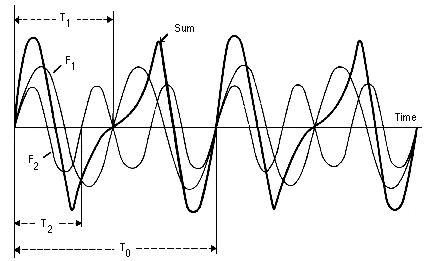If a sound is a complex of many TONEs of various FREQUENCY, AMPLITUDE and PHASE, repeating together in a basic CYCLE of definite frequency, the fundamental is the lowest frequency of this complex and corresponds to the unique PITCH heard in such a COMPLEX TONE.
The fundamental does not necessarily have the greatest amplitude, however, and even if missing (such as in the case of a low voice speaking through the carbon MICROPHONE of a telephone) the brain will still identify that frequency as the fundamental, called the periodicity pitch or missing fundamental. This ability of the auditory system is called fundamental tracking.

The dark line shows the sum of the second and third harmonics (F1, F2 respectively) whose periodicities (T1, T2 respectively) repeat at the same period (T0) as the fundamental. After J. Roederer, Introduction to the Physics and Psychophysics of Music, Springer, 1975.
In some percussion instruments with many INHARMONIC partials such as bells, the fundamental or hum note is different from the perceived pitch of the instrument called the strike note.
![]() Sound
Example: Large bell, Salzburg, Austria,
with a very low hum note and a higher strike note.
Sound
Example: Large bell, Salzburg, Austria,
with a very low hum note and a higher strike note.
In music the fundamental is the lowest tone in the HARMONIC series or the root tone of a chord.
See: FORMANT, FOURIER ANALYSIS, HARMONIC SERIES, sound example under LAW OF SUPERPOSITION, OCTAVE, OVERTONE, PARTIAL, RESIDUE, SUBHARMONIC. Compare: KEYNOTE SOUND.
home